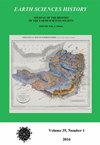开采铅笔,雕刻石墨:J.-P. ALIBERT(1844-1857 年)的西伯利亚探险和不断发展的 19 世纪欧洲与地球科学有关的视觉物质文化ALIBERT(1844-1857)和不断发展的19世纪欧洲与地球科学有关的视觉和物质文化
IF 0.6
4区 哲学
Q4 GEOSCIENCES, MULTIDISCIPLINARY
引用次数: 0
摘要
本文通过对让-皮埃尔-阿利伯特(1820-1905 年)在西伯利亚的考察(1844-1857 年)的案例研究,探讨了 19 世纪下半叶地球科学、采矿和视觉艺术之间建立的关系。阿利贝尔是一位法国商人,他在西伯利亚发现了一个重要的石墨矿藏。随后,他建造了一座矿山,开采这种在铅笔生产中需求量很大的材料。1857 年,阿利伯特回到欧洲,他创作了一本水粉画册来纪念他的探险,并向巴黎的重要科学机构提供了一些由石墨和软玉组成的雕塑,作为探险的战利品。虽然有一些文字资料,但我将直接质疑这些视觉和物质资料,将这一案例研究置于当时的时代背景、地球科学的进步和技术成就之中,以揭示重新寻求与地球科学有关的科学视觉语言的现象。本文章由计算机程序翻译,如有差异,请以英文原文为准。
MINING PENCILS, SCULPTING GRAPHITE: THE SIBERIAN EXPEDITION OF J.-P. ALIBERT (1844–1857) AND THE EVOLVING 19TH CENTURY EUROPEAN VISUAL AND MATERIAL CULTURE RELATED TO EARTH SCIENCES
This article explores, through a case study of Jean–Pierre Alibert's (1820–1905) expedition in Siberia (1844–1857), the relationship established between Earth sciences, mining, and visual arts during the second half of the 19th century. Alibert was a French businessman who discovered an important deposit of graphite in Siberia. He then built a mine to exploit this material which was in high demand to produce pencils. When Alibert returned to Europe in 1857, he created an album of gouaches to commemorate his expedition, and he offered some sculptures composed of graphite and nephrite jade to important scientific institutions in Paris as trophies of the expedition. While a few written sources are available, I will directly question these visual and material sources to situate this case study within the context of its time, and of Earth sciences’ progress and technical achievements, to shed light on the phenomena that characterized the quest for a renewed scientific visual language related to Earth sciences.
求助全文
通过发布文献求助,成功后即可免费获取论文全文。
去求助
来源期刊

Earth Sciences History
GEOSCIENCES, MULTIDISCIPLINARY-HISTORY & PHILOSOPHY OF SCIENCE
CiteScore
1.00
自引率
0.00%
发文量
1
审稿时长
>12 weeks
期刊介绍:
Earth Sciences History promotes and publishes historical work on all areas of the earth sciences – including geology, geography, geophysics, oceanography, paleontology, meteorology, and climatology.
The journal honors and encourages a variety of approaches to historical study: biography, history of ideas, social history, and histories of institutions, organizations, and techniques.
Articles are peer reviewed.
 求助内容:
求助内容: 应助结果提醒方式:
应助结果提醒方式:


